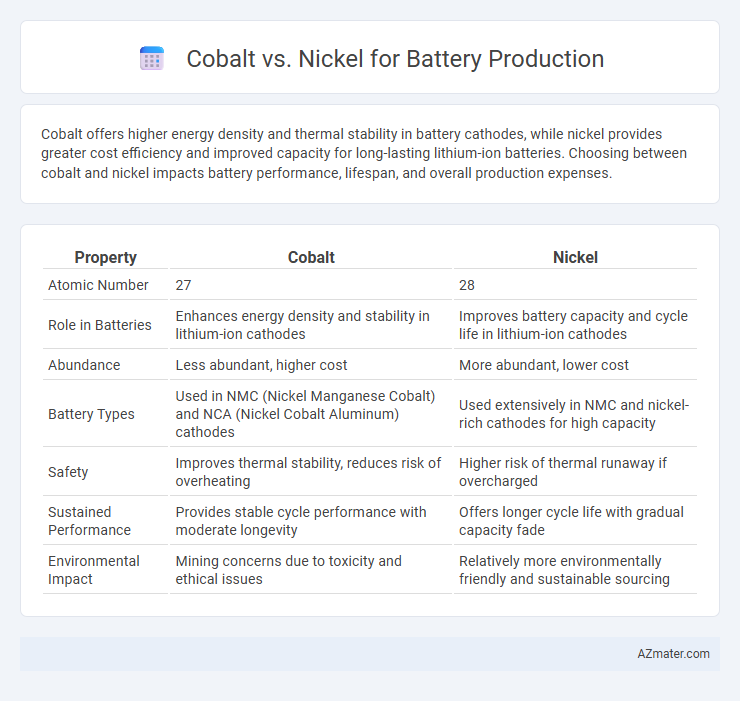Cobalt offers higher energy density and thermal stability in battery cathodes, while nickel provides greater cost efficiency and improved capacity for long-lasting lithium-ion batteries. Choosing between cobalt and nickel impacts battery performance, lifespan, and overall production expenses.
Table of Comparison
| Property | Cobalt | Nickel |
|---|---|---|
| Atomic Number | 27 | 28 |
| Role in Batteries | Enhances energy density and stability in lithium-ion cathodes | Improves battery capacity and cycle life in lithium-ion cathodes |
| Abundance | Less abundant, higher cost | More abundant, lower cost |
| Battery Types | Used in NMC (Nickel Manganese Cobalt) and NCA (Nickel Cobalt Aluminum) cathodes | Used extensively in NMC and nickel-rich cathodes for high capacity |
| Safety | Improves thermal stability, reduces risk of overheating | Higher risk of thermal runaway if overcharged |
| Sustained Performance | Provides stable cycle performance with moderate longevity | Offers longer cycle life with gradual capacity fade |
| Environmental Impact | Mining concerns due to toxicity and ethical issues | Relatively more environmentally friendly and sustainable sourcing |
Introduction: The Role of Metals in Battery Technology
Cobalt and nickel are essential metals in battery production, significantly enhancing energy density and cycle life in lithium-ion batteries. Cobalt stabilizes the cathode structure, improving safety and longevity, while nickel increases energy capacity and reduces costs by partially replacing cobalt. The balance between cobalt and nickel content directly influences battery performance, cost-efficiency, and sustainability in electric vehicle and portable electronics industries.
Cobalt Overview: Properties and Uses in Batteries
Cobalt is a critical component in lithium-ion batteries due to its high energy density and thermal stability, which enhances battery life and safety. Its ability to improve electrode performance and structural stability makes it essential for powering electric vehicles and portable electronics. The strategic use of cobalt increases battery efficiency, but supply chain concerns and ethical sourcing challenges drive ongoing research into cobalt reduction or substitution with nickel.
Nickel Overview: Properties and Uses in Batteries
Nickel's high energy density, corrosion resistance, and stable electrochemical properties make it a critical component in lithium-ion battery cathodes, especially in nickel-rich formulations like NMC (Nickel Manganese Cobalt) and NCA (Nickel Cobalt Aluminum) batteries. Its ability to enhance battery capacity and cycle life while reducing reliance on scarce and expensive cobalt aligns with industry trends towards sustainable and cost-effective energy storage solutions. Nickel's widespread availability and improving extraction technologies further drive its preference over cobalt in large-scale electric vehicle and grid storage applications.
Energy Density: Cobalt vs Nickel Performance
Nickel offers higher energy density compared to cobalt, making it a preferred choice for enhancing battery capacity and driving range in electric vehicles. Cobalt contributes to battery stability and thermal management but has lower specific energy density than nickel. Optimizing nickel content in lithium-ion batteries increases energy density while maintaining safety and longevity.
Cost Analysis: Comparing Cobalt and Nickel
Nickel generally offers a lower cost per kilogram than cobalt, making it more economical for large-scale battery production. Cobalt prices tend to be higher due to limited supply and geopolitical risks associated with its primary mining regions, particularly the Democratic Republic of Congo. Battery manufacturers increasingly favor nickel to reduce raw material costs while maintaining energy density and performance.
Supply Chain and Availability
Nickel boasts a more abundant global supply with major reserves in Indonesia, the Philippines, and Russia, offering a relatively stable and scalable source for battery production compared to cobalt. Cobalt concentration is limited, predominantly mined in the Democratic Republic of Congo, which raises concerns about ethical sourcing, geopolitical risks, and supply chain disruptions. Battery manufacturers are increasingly prioritizing nickel-rich chemistries to reduce dependency on cobalt and enhance supply chain resilience amid growing electric vehicle demand.
Environmental Impact and Sustainability
Cobalt mining often results in significant environmental degradation and ethical concerns due to its concentrated extraction regions and toxic waste generation, whereas nickel production typically has a larger carbon footprint but benefits from more established recycling systems. Sustainable battery manufacturing increasingly prioritizes nickel-rich chemistries to reduce reliance on cobalt, whose supply chain involves higher social and environmental risks. Improvements in nickel extraction technologies and increased recycling rates contribute to lowering the overall environmental impact compared to cobalt-dependent batteries.
Safety and Stability in Battery Applications
Cobalt offers higher thermal stability and reduced risk of overheating compared to nickel, making it a safer choice for battery applications. Nickel, while increasing energy density and capacity, can lead to higher internal temperatures and potential safety hazards such as thermal runaway. Optimizing the cobalt-to-nickel ratio in battery cathodes is critical for balancing safety, stability, and performance in lithium-ion batteries.
Technological Advancements and Trends
Technological advancements in battery production increasingly emphasize reducing cobalt content due to ethical and supply chain concerns, while nickel-rich chemistries such as NMC 811 (nickel-manganese-cobalt) enhance energy density and cost efficiency. Innovations in solid-state battery technology and cathode materials aim to optimize nickel utilization, improving cycle life and safety without compromising performance. Emerging trends prioritize sustainable sourcing and recycling of both cobalt and nickel to support scalable and eco-friendly lithium-ion battery manufacturing.
Future Outlook: Cobalt vs Nickel in Next-Gen Batteries
Nickel is expected to play a dominant role in next-gen battery production due to its higher energy density and lower cost compared to cobalt, which faces supply constraints and ethical concerns. Advances in nickel-rich cathode chemistries like NMC 811 and solid-state batteries highlight nickel's potential for enhanced performance and scalability. Cobalt use is anticipated to decline as manufacturers seek to minimize reliance on this critical metal while maintaining battery safety and stability.

Infographic: Cobalt vs Nickel for Battery production
 azmater.com
azmater.com